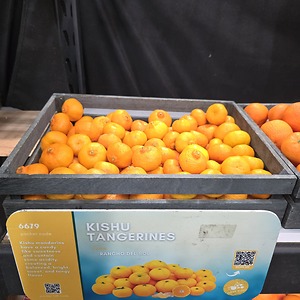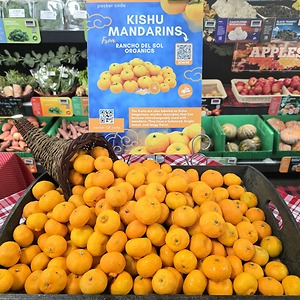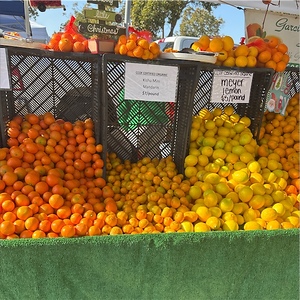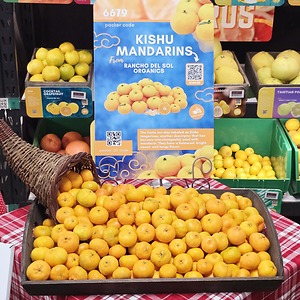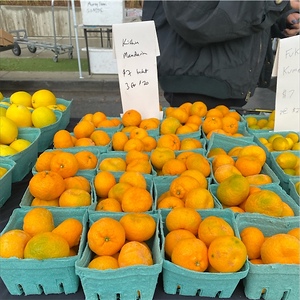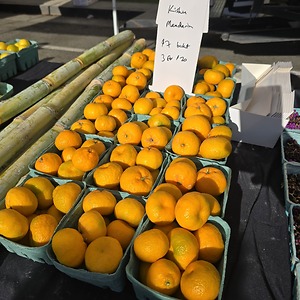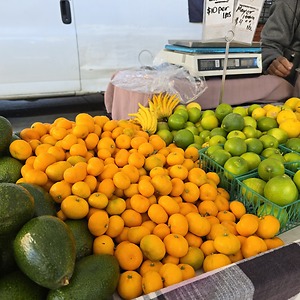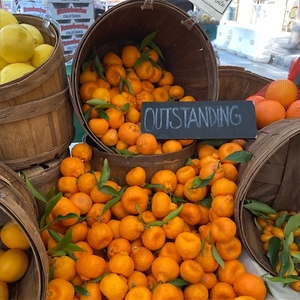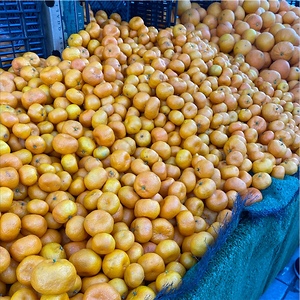

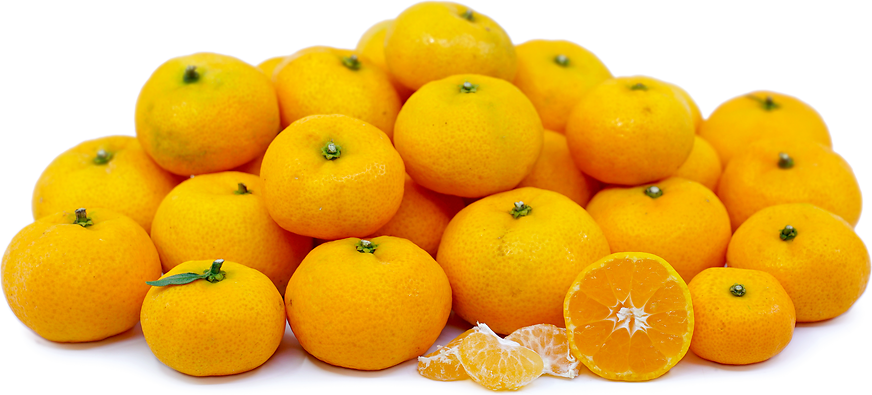
Kishu Mandarins
Estimated Inventory, lb : 0
This item was last sold on : 02/21/25
Description/Taste
Kishu mandarins are small fruits, averaging 2 to 5 centimeters in diameter, and have a round to oblate shape, about the size of a walnut. The mandarins are depressed at both ends, giving them a slightly squat appearance, and the rind is thin, smooth, and glossy. The rind also showcases a bright orange hue and is covered in tiny oil glands that release a light and aromatic fragrance. Kishu mandarins are easily peeled, revealing a thin layer of pith encasing small, divided sections. Each fruit may contain 7 to 14 segments and bears a semi-firm but tender, aqueous consistency. Depending on the variety, the dark orange flesh is also either found seedless or includes a few ivory seeds. Kishu mandarins have high sugar content, ranging from 11 to 14 Brix, a measurement of sugar within the flesh, contributing to the fruit’s candy-like sweetness. Despite their sugar content, Kishu mandarins also contain some acidity, creating a balanced, bright, sweet, and tangy flavor.
Seasons/Availability
Kishu mandarins are available for a short season in the winter.
Current Facts
Kishu mandarins, botanically classified as Citrus kinokuni, are a small citrus variety belonging to the Rutaceae family. The mandarins grow on dwarf-sized evergreen trees that reach 2 to 3 meters in height and are originally native to China, where some Kishu trees are hundreds of years old. In ancient times, Kishu mandarins spread throughout Asia and became a favored fresh eating fruit, especially in Japan. There are two main types of Kishu mandarins, with Kira Kishu being larger and flatter, while the Mukaka Kishu is generally smaller and seedless. Kishu mandarins are known as Kishu Mikan in Japan, with “mikan” translating to mean “mandarin.” The fruits are also labeled as Kishu tangerines, another descriptor that has become interchangeably used with mandarin. Outside of Japan, Kishu mandarins are marketed under other names, including Cherry oranges, Baby mandarins, Tiny tangerines, Little Wonders, and Kishu Kisses. The fruits are not cultivated commercially due to their delicate nature, small size, and challenging growing requirements, leading the variety to be regarded as a specialty cultivar. Kishu mandarins are traditionally hand-harvested and are sold through local markets. The small fruits are widely valued among citrus enthusiasts, and some markets sell out of their entire harvest within 1 to 2 weeks.
Nutritional Value
Kishu mandarins are a source of vitamin C to strengthen the immune system, vitamin A to maintain healthy organ functioning, and fiber to regulate the digestive tract. The mandarins also provide potassium to balance fluid levels within the body, calcium to protect bones and teeth, copper to produce connective tissues, and antioxidants in the form of flavonoids and phytochemicals to guard the cells against free radical damage.
Applications
Kishu mandarins have a balanced, sweet-tart flavor well suited for fresh eating. The fruits are easily peeled and popularly consumed straight, out of hand, as a snack. The mandarins can also be segmented and mixed into fruit dishes, green salads, or stirred into grain bowls. In addition to bowls, Kishu mandarins can be displayed on cheese platters, segmented and dipped in chocolate, or separated and used as a garnish on cakes, tarts, and other desserts. The fruit’s novel, small size can also be used as decorative, edible centerpieces, utilized as a fresh topping over yogurt, ice cream, and sorbet, or infused into marinades, dressings, vinaigrettes, sauces, and syrups. In Japan, Kishu mandarin peels are frequently dried and ground into shichimi togarashi, a flavorful spice mixture comprised of chili powder, sesame seeds, ginger, poppy seeds, and seaweed, served with roasted meats, vegetables, and rice or noodle dishes. Kishu mandarins pair well with other fruits such as strawberries, blueberries, grapes, pineapple, and kiwi, chocolate, vanilla, caramel, soft cheeses, and seafood such as white fish, crab, and shrimp. Whole, unpeeled Kishu mandarins will keep up to one week when stored at room temperature or 1 to 2 weeks when kept in the refrigerator.
Ethnic/Cultural Info
Kishu mandarins are a popular home garden variety in Japan and are favored for the fruit’s small size. The backyard mandarins can be found in seeded and seedless varieties, and despite the modern-day desire for seedless fruits, seeded mandarins were once the preferred type in ancient Japan. Throughout the Edo and Meiji eras, many families believed that seeds in citrus represented offspring and family members. Consuming seeded fruit was thought to bring blessings towards healthy lineages, but seedless fruits were viewed as bad omens and were believed to bring the end of family trees. This superstition helped spread Kishu mandarins in cultivation, as the original fruits were mainly full of seeds.
Geography/History
Kishu mandarins are native to Southern China, and experts believe that small mandarin fruits have been cultivated in China since the 8th century. Mandarins were traditionally reserved for the emperor and nobility, recorded in Jianchang county during the Ming Dynasty. Over time, mandarins were cultivated throughout the Jiangxi province and were later introduced to Japan in the Kumamoto Prefecture during the 13th century. Kishu mandarins were one of the most popular types of citrus in Tokyo until around 1880 when the larger satsuma mandarin was introduced. Outside of Asia, seeded Kishu mandarins were introduced to California and Florida of the United States in the 1800s, described by B.M. Lelong in 1888, but the variety remained relatively unknown. In 1983, seedless Kishu mandarins were introduced from Japan to the UC Riverside Citrus Variety Collection. Citrus grower Jim Churchill obtained the seedless variety from the collection and planted it in his orchards in Ojai, California, establishing the first commercial Kishu orchard in the United States in the 1990s. Today Kishu mandarins are cultivated throughout Asia, Europe, Australia, and California, and Florida. The small fruits are also grown in home gardens as a specialty variety. When in season, the mandarins are typically found through farmer’s markets and distributors.
Recipe Ideas
Recipes that include Kishu Mandarins. One
| Arctic Garden Studio |
|
Kishu Mandarin Greek Yogurt Souffle |



